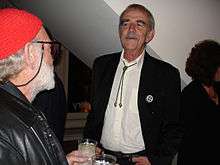William T. Wiley
| William T. Wiley | |
|---|---|
 William T Wiley in San Francisco, 2006, photograph by Sally Larsen | |
| Born |
October 21, 1937 Bedford, Indiana, US |
| Nationality | American |
| Education | California School of Fine Arts |
| Known for | drawing, painting, sculpture, film, and performance |
| Awards | Purchase Prize from the Whitney Museum of American Art 1968. Honorary Doctorate at San Francisco Art Institute, San Francisco, California 1980. 2004 Guggenheim Fellowship Award. |
William T. Wiley (born October 21, 1937)[1] is an American artist. His practice spans a broad range of media including drawing, painting, sculpture, film, performance, and pinball. At least some of Wiley's work has been referred to as funk art.[2]
Life and work
He was born in Bedford, Indiana. Raised in Indiana, Texas, and Richland, Washington, Wiley moved to San Francisco to study at the California School of Fine Arts where he earned his BFA in 1960 and his MFA two years later.[3] In 1963, Wiley joined the faculty of the UC Davis art department with Bay Area Funk Movement artists Robert Arneson and Roy DeForest. During that time Wiley instructed students including Bruce Nauman and Deborah Butterfield.[4] According to Dan Graham, the literary, punning element of Nauman's work came from Wiley.[5] Wiley also acknowledges the effect Nauman had on his own work.[6]
His first solo exhibition was held at the San Francisco Museum of Modern Art in 1960.
In the late 1960s Wiley collaborated with the minimalist composer Steve Reich and introduced him to Bruce Nauman.[7]
Wiley continued to build upon his growing stature as a major artist with works appearing in the Venice Biennial (1980) and Whitney Biennial (1983). He also had major exhibitions at the San Francisco Museum of Modern Art (1981), M. H. de Young Memorial Museum, San Francisco (1996), and the Corcoran Gallery of Art, Washington, D.C. (2005).[8]
In 2009, the Smithsonian American Art Museum presented a retrospective of Wiley's career titled What's It All Mean: William T. Wiley in Retrospect, from October 2, 2009 through January 24, 2010. A review in the Wall Street Journal stated: "Mr. Wiley's work is unlike any other in recent art... He is less a contemporary artist than a national treasure." [9][10]
In 2010, the retrospective moved to the Berkeley Art Museum, from March 17 to July 18. The catalogue for the retrospective, "What's It All Mean: William T. Wiley in Retrospect", was co-published by the Smithsonian American Art Museum and University of California Press.[11]
Wiley also has works in the collections of the Art Institute of Chicago, the Museum of Modern Art, New York, the Whitney Museum of American Art, New York, the Corcoran Gallery of Art, Washington D.C., the San Francisco Museum of Modern Art, the Hirshhorn Museum and Sculpture Garden, Washington, D.C., the Los Angeles County Museum of Art, and the Museum of Fine Arts, Boston, among many others. Wiley was the recipient of the Guggenheim Fellowship Award in 2004.[8] He is represented by Hosfelt Gallery[12] in San Francisco and by Maxwell Davidson Gallery in New York City.
Collections[13]
- Art Institute of Chicago
- Baltimore Museum of Art
- di Rosa[14]
- Dallas Museum of Art
- Denver Art Museum
- Los Angeles County Museum of Art
- Minneapolis Institute of Arts
- Museum of Fine Art, Boston
- Museum of Modern Art, New York
- New Britain Museum of American Art, Connecticut
- Nelson-Atkins Museum, Kansas City, Missouri
- Philadelphia Museum of Art
- San Francisco Museum of Modern Art
- Smithsonian American Art Museum, Washington, D.C.
- Van Abbemuseum, Eindhoven, Netherlands
- Walker Art Center, Minneapolis
- Whitney Museum of American Art
References
- ↑ http://www.williamtwiley.com/Wiley%20Words/Wiley06bio.pdf
- ↑ Artspeak, by Robert Atkins, 1990, ISBN 1-55859-127-3
- ↑ William Wiley - San Francisco Art Institute
- ↑ myartspace>blog: Art Space Talk: William T. Wiley
- ↑ Dan Graham, Alexander Alberro, Two-Way Mirror Power: Selected Writings by Dan Graham on His Art, MIT Press, 1999, p112. ISBN 0-262-57130-7
- ↑ Wiley quoted by Paul J. Karlstrom in Stephanie Barron, Sheri Bernstein, Ilene Susan Fort, Reading California: Art, Image, and Identity, 1900-2000, University of California Press, 2000, p100. ISBN 0-520-22767-0
- ↑ Robert C. Morgan, Bruce Nauman, JHU Press, 2002, p61. ISBN 0-8018-6906-4
- 1 2 http://www.williamtwiley.com
- ↑ http://americanart.si.edu/exhibitions/archive/2009/wiley/
- ↑ http://online.wsj.com/article/SB10001424052748703683804574532482514890604.html
- ↑ http://www.amazon.com/dp/0520261216
- ↑ http://hosfeltgallery.com
- ↑ List of Collections from http://www.magical-secrets.com/artists/wiley
- ↑ "The Collection". dirosaart.org. Retrieved 2016-11-03.
Further reading
- Joann Moser with John Yau and John G. Hanhardt; WHAT'S IT ALL MEAN, WILLIAM T. WILEY, IN RETROSPECT; Smithsonian American Art Museum, University of California Press, Berkeley 2009; ISBN 978-0-520-26120-4
External links
- Official website
- On KQED's Spark program
- YOU SEE Panel discussion with Manuel Neri and Wayne Thiebaud
- Punball: Only One Earth, O.O.E.
- Video interview and artist's films at www.artbabble.org
- In Case You Missed the Revolution, Man New York Times review of Wiley's 2009-2010 Smithsonian American Art Museum show.
- He's Wily, And Witty Wall Street Journal of Wiley's 2009-2010 Smithsonian American Art Museum show.